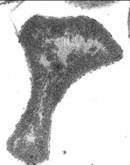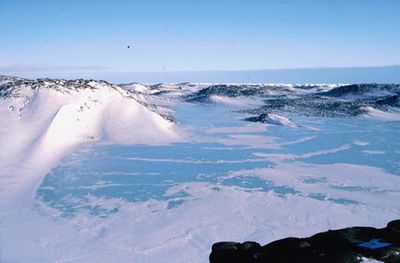Methanogenium frigidum
Classification
- Domain: Archaea
- Kingdom: Euryarchaeota
- Phylum: Euryarchaeota
- Class: Methanomicrobia
- Order: Methanomicrobiales
- Family: Methanomicrobiaceae
- Genus: Methanogenium
- Species: Methanogenium frigidum
- M. frigidum is named as such because the microbe is a methanogen that lives in very cold temperatures.
Description
M. frigidum is an extremophile found in Ace Lake in Antarctica, and is also found in deep-sea trenches that have a similar ecosystem as the one found at the bottom of Ace Lake. It thrives in the anoxic hypolimnion layer of the lake, and shows best growth at 15 degrees Celsius; however, it will cease growth at temperatures above 20 degrees Celsius. There is also a lot of methane present in the ecosystem, due to the methanogens living in the lake. M. frigidum is the first sequenced extremophile living in cold temperatures that is also a methanogen that grows by CO2 reduction. The cells are irregularly shaped coccoids and are about 1.2 to 2.5 microns in diameter. M. frigidum is gram negative and nonmotile, there are not any pili or flagella on the outside of the cells. The cells grow the best at a fairly neutral pH, it’s best growth occurring in the 6.5- 7.9 pH range. It is extremely slow growing, and can survive without oxygen or sunlight. There are flexible proteins present in M. frigidum that help the microbe survive in extreme temperatures, as well as cold-shock proteins that allow basic cell functions to continue in the ecosystem that it lives. M. frigidum grows by CO2 reduction, and uses H2 as it's electron donator. M. frigidum was sequenced in order to study extremophiles living in conditions uncommon for most life. It is believed that many of these microbes support the possibility of life on other planets. In particular, there is evidence to suggest that there might be oceans beneath the surface of Europa, Jupiter’s sixth moon, which could support the life of M. frigidum.
Genome
M. frigidum’s genome is approximately 2 to 2.5 million base pairs in length, and it contains 1815 candidate protein coding genes. Due to M. frigidum’s psychrophilic lifestyle, the content of the genome itself has adapted to better reproduce itself in cold conditions; it codes for a high amount of noncharged polar amino acids (particularly glycine and threonine) and low levels of hydrophobic amino acids (leucine, in particular). Many species within the genus Methanogenium are thermophilic or hyperthermophilic, and consequently the G/C content of their genomes is significantly higher than that of comparable mesophilic organisms, in order to retard the process of heat-induced strand seperation. M. frigidum, however, has adapted to protect its genome from its temperature extreme by relying on DNA binding domains of Cold Shock Proteins to stabilize the structure.
Metabolism
M. frigidum is a CO2 reducing methanogen that uses H2 as a reductant, or electron donor. The microbe can use formate in the place of H2, but it is not as efficient. Since M. frigidum is slow growing anyway, it is much more beneficial for the microbe to use H2 instead of formate as the electron donator. M. frigidum is unable to grow and reproduce without some form of NaCl in the environment, and does not produce NaCl itself. Most marine methane formed by living organisms is the result of carbon dioxide reduction processes. Sulfide can be used as the sole source of sulfur in the metabolic processes of M. frigidum.
Nitrogen
M. frigidum can grow using ammonia as the only source of nitrogen, this is a sufficient source for the microbe.
Carbon
M. frigidum needs a carbon source besides CO. In order to grow, it needs to use acetate as the source of carbon for the metabolic functions. Acetate, trimethylamine, and methanol are not catabolized in these metabolism processes. In a culture medium, it was found that cells could grow with acetate as the only organic compound present; however, growth was faster in the microbe if yeast extract and peptones were also present with the acetate.
Ecology
M. frigidum has adapted to grow in salty, anoxic aquatic conditions. The microbe has been found in deep sea trenches, but most studies of the organism are conducted on cells from Ace Lake, in Antarctica. Found within the anoxic hypolimnion, where temperatures average around 1-2 degrees Celsius, the non-motile M. frigidum relies on diffusion and transport of hydrogen and carbon dioxide dissolved in the water for its energy. The strata in which M. frigidum dwells does not support populations of methanotrophic organisms, and consequently very little of the methane the microbe generates is utilized. The lake, close to the coast, was converted from freshwater to saltwater due to fluctuations in sea level during the Holocene climate shifts. As a result, the lake’s ecological somewhat resembles that of marine environments; a significant amount of bioavailable carbon is sequestered and cycled through predatory bacteriophages, and a great deal of the archaeal and bacterial genes originate from marine dwelling microbes.
References
- Dalke, K. (2003, July 25). In Extremophiles, Antarctica, and Extraterrestrial Life. Retrieved April 18, 2014, from http://www.genomenewsnetwork.org/articles/07_03/extremo.shtml
- Franzman PD, Liu Y, Balkwill DL, Aldrich HC, Conway de Macario E, Boone DR. Methanogenium frigidum sp. nov., a psychrophilic, H2-using methanogen from Ace Lake, Antarctica. International Journal of Systematic and Evolutionary Microbiology (1997) 1068-1072
- Laura Giaquinto, Paul M. G. Curmi, Khawar S. Siddiqui, Anne Poljak, Ed DeLong, Shiladitya DasSarma, Ricardo Cavicchioli. Structue and Function of Cold Shock Proteins in Archaea. (2007) Journal of Bacteriology 189(15): 5738-5748.
- Reed CJ, Lewis H, Trejo E, Winston V, Evilia C. Protein Adaptations in Archaeal Extremophiles. (2013) Archaea.
- Yau S, Lauro FM, DeMaere MZ, Brown MV et al. (2011). An Integrative Study of a Meromictic Lake Ecosytem in Antarctica. ISME Journal 5: 879-895


